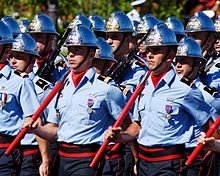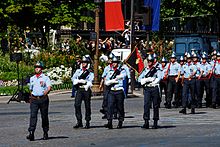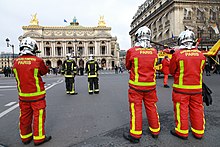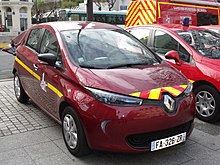Paris Fire Brigade
| Brigade des sapeurs-pompiers de Paris | |
|---|---|
 The Brigade during the 2008Bastille Dayparade | |
| Active | 1793–present |
| Country | |
| Branch | French Army |
| Type | Firemen |
| Size | ~ 8,500 |
| Motto(s) | "Sauver ou périr"(Save or Perish) |
| Colors | Red & black |
TheParis Fire Brigade(French:Brigade des sapeurs-pompiers de Paris,BSPP) is aFrench Armyunit which serves as the primary fire and rescue service forParis,the city's inner suburbs and certain sites of national strategic importance.
The brigade's main area of responsibility is the City of Paris and the surroundingdépartementsofSeine-Saint-Denis,Val-de-Marne,andHauts-de-Seine(thepetite couronne). It also serves theCentre Spatial GuyanaisinKourou,theDGAMilitary Rocket Test Centre inBiscarosse,and theLacq gas field.As with the other fire services of France, the brigade providestechnical rescue,search and rescueandfire preventionservices and is one of the providers ofemergency medical services.
The brigade is one of two fire services in France that is part of the armed forces, with the other being theMarseille Naval Fire Battalion(BMPM). It is a unit of theFrench Army'sEngineering Arm(l'arme du génie) and the firefighters are thereforesappers(sapeurs,thussapeurs-pompiers). With 8,550 firefighters, it is the largest fire service in Europe and the third largest municipal urban fire service in the world, after theTokyo Fire DepartmentandNew York City Fire Department.Its motto is"Save or Perish"(French "Sauver ou périr").
History
[edit]
Founded in 1793 as theCorps des gardes-pompes de la ville de Parisand following the 23-hourAustrian Embassy Firein 1810 became a military organisation by imperial decree of EmperorNapoléon.On 18 September 1811, it became theBataillon de sapeurs-pompiers de Parisand was expanded to theRégiment de sapeurs-pompiers de Parisin 1867. During the Franco-Prussian War and World War I the sapeurs-pompiers were mobilised for military service, while continuing to fulfill their firefighting responsibilities.
On 1 March 1967, it became theBrigade des sapeurs-pompiers de Paris.
Selection and training
[edit]The operational personnel (hommes du rangi.e. other ranks or rank and file) are usually engaged for five years. They must have French nationality, be between 18 and 25 years old, have a cleancriminal recordand have at least avocational trainingCAPcertificate.The selection is three days long, with sports tests, psychomotor tests, medical examination, etc.
Training takes place in the Training Group (Groupement d'instruction,GI), at the fort ofVilleneuve-Saint-Georges.The first period lasts two months, with thefirst aidandfirst respondertraining, and basic military instruction (including shooting). They then undertake practical training of four months in an operational fire company (compagnie d'incendie); this includes taking part in personal assistance and utility safety operations. The last stage of training is a further two months at the Training Group. Upon completing training, the firefighter joins a fire company.
Resources
[edit]
The BSPP consists of 8,550 personnel with 81 stations and facilities who conduct 1,200 operations daily.
- 463 pieces of equipment
- 130Pumpers
- 63 Aerial Devices
- 66 Ambulances
- 71 Command and Patrol vehicles
- 133 Special Engines
Organisation
[edit]
The brigade is commanded by aBrigade Generalas part of the French Army's engineering arm. The brigade commander directly controls the Information and Public Relations Bureau, and who is assisted a Colonel-Adjutant, a General Council called a Cabinet and aChief of Staffwho controls the following Bureaus:
- General Studies Bureau
- Financial Programs and Budget Bureau
and three Assistant Chiefs of Staff:
- Assistant Chief for Employment
- Operations Bureau
- Formation and Instruction Bureau
- Prevention Bureau
- Assistant Chief for Logistics
- Techniques Service
- Infrastructure Service
- Administrative Service
- Telecommunications and Information Service
- Assistant Chief for Human Resources
- Human resources Bureau
- Personnel Welfare Bureau
- Chief Doctor
- Emergency medical service/SAMU
- Chief of the Health Service
Operational staff are divided into three geographic groups, as well as a training group and a services group. The geographic groups are:
- First fire group – northeast Paris andSeine-Saint-Denis
- Second fire group – southeast Paris andVal-de-Marne
- Third fire group – west Paris andHauts-de-Seine
Each of the geographic groups consists of 8 fire companies and a few special units that are not part of a company (including ambulance units). Each company in turn consists of 2-4 fire stations.
First fire group (Premier groupement d'incendie)
[edit]
TheFirst fire groupof the Paris Fire Brigade covers northeast Paris andSeine-Saint-Denisand is based in the18th arrondissement of Paris.It consists of the following companies:
- 7th at Blanche
- 9th atMontmartre
- 10th at Landon
- 12th atMénilmontant
- 13th atAulnay-sous-Bois
- 14th atClichy-sous-Bois
- 24th atMontreuil
- 26th atSaint-Denis
Additional units include:
Second fire group (Deuxième groupement d'incendie)
[edit]
TheSecond Fire Groupof the Paris Fire Brigade covers Southeast Paris andVal-de-Marneand is based in the13th arrondissement of Paris.It consists of the following companies:
- 1st atChaligny
- 2nd atMassena
- 8th atRousseau
- 11th atSévigné
- 15th atChampigny
- 17th atCréteil
- 22nd atRungis
- 23rd atSaint-Maur
Additional units include:
Third fire group (Troisième groupement d'incendie)
[edit]
TheThird Fire Groupof the Paris Fire Brigade covers Western Paris andHauts-de-Seineand is based inCourbevoie,Hauts-de-Seine.It consists of the following companies:
- 3rd at Port Royal
- 4th at Colombier
- 5th atChamperret
- 6th atGrenelle
- 16th atBoulogne
- 21st atPlessis Clamart
- 27th atGennevilliers
- 28th atNanterre
Additional units include:
Training Group (Groupement d'instruction)
[edit]
TheTraining Groupof the Paris Fire Brigade provides education and training to all Parisfirefighters.It consists of the following:
- Group Staff
- EMS/SAMU
- Center for Formation and Cadres
- Center for the Instruction of Recruits
- Basic Training Company
- Auto School, driving and repairs
- Support Company
Special services
[edit]
Controlled by Headquarters
- Divers/SCUBA
- Search and Rescue
- Canine Service
- Paris Fire Brigade Band
- Gymnastic Team
- Air Service
- Boat Service
Frequency of operations
[edit]

The BSPP performs about 1200 interventions per day. During 2001:
- 1st fire group: 163,081 interventions, including 9,606 fires
- 2nd fire group: 136,078 interventions, including 5,583 fires
- 3rd fire group: 150,376 interventions, including 5,234 fires
There are 6.16 million inhabitants in the BSPP zone (1999). This represents:
- per day: 19 interventions per 100,000 inhabitants
- per year: 7,300 interventions, including 331 fires, per 100,000 inhabitants
Ceremonial duties
[edit]Traditionally,[1]the Paris Fire Brigade parades twice during theBastille Day military parade:once on foot, and a second time with its vehicles. During the parade members are armed due to their membership in the armed forces.
Evening dance parties are held at fire stations on (or near to) Bastille Day. These are known as aBal des pompiers[2](firefighters' ball).
See also
[edit]References
[edit]- ^"[14 juillet 2012] Le bonheur simple du défilé militaire".5 July 2012.
- ^"Liste des Bals du 13 et 14 juillet 2013"[List of Balls on July 13 and 14, 2013] (in French). 12 July 2013. Archived fromthe originalon 31 August 2014.
